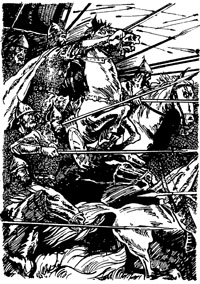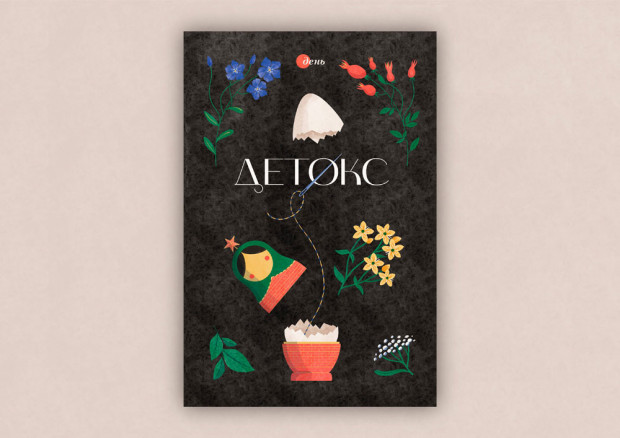WHAT CAUSED THE DECLINE AND FALL OF RUS’?

The roots of the Eastern Slavs are traced to the territory once inhabited by the Rusyches and their ancient capital, Kyiv. Studies of ancient manuscripts and chronicles prompt one to refer to most interesting sources pointing the reason for all our troubles. Who laid the foundations of all those deep-going structural, economic, political, and social cataclysms currently present in all Ukrainian social strata?
Kyiv Rus’ was a territory inhabited by Slavic tribes, stretching from the Khazar steppes to the Carpathian Mountains, from one sloboda (large village on a high road) to the next, from the Poliane, Drevliane, Dulibs, White Croats, Ulychi, Tyvertsi, Kryvychi, and Viatychi tribes to the thick wild Prypyat Marshes. No one knows precisely how many tribes lived there and spoke Slavic dialects.
The appearance of Slavic tribes on the territory of present- day Ukraine, their being mentioned in old chronicles as Slovyane-Venedy embraces a period from first and second centuries AD until their peak in the rise and fall of Kyiv Rus’. In the second half of the first millennium, Eastern Slavs settled a territory from Lake Ilmen to the northern Black Sea littoral, forming a number of allied tribal associations that would go down in history as tribal principalities or chronicle tribes. They laid the foundations of an Eastern Slavic polity, Kyiv Rus’, formed in the ninth century. Archaeological evidence shows that the Slavic tribal cultures in that vast territory had much in common. Ancient settlements, fortified cities, religious and burial rites (cremation) followed by wakes, buildings of stone and clay, tribal laws and customs, linguistic unity, and general literacy were characteristic of Eastern Slavic culture. Simultaneously, each Slavic group had its distinctions — vernacular, embroidery, ceramic techniques, etc.
EASTERN SLAVS AND THEIR COMMUNAL ADMINISTRATION
What was the social organization of the Eastern Slavs like and why were the relations based on mutual contacts that lasted for millennia in their midst, later irretrievably lost?
Experts on early history note one remarkable feature that united our ancestors and other social poleis [city-states] in the period. The system of administration at all levels relied, on the one hand, on decisions made by tribal elders, princes elected to command military campaigns, and magi, old Slavic shamans who undoubtedly constituted the social elite. On the other hand, social organization was based on the tribe or clan. Each tribe was a form of social self-government coping with vital problems, determining relationships at all levels. The elders would call a viche (popular assembly) to make and approve decisions. This phenomenon was a unique manifestation of the people’s will.
The viche allowed the Slavs belonging to a given tribe being in attendance to voice their opinion and make a joint decision. There is another unique aspect; all members of the tribe adhered to deep- going principles of relationships, namely honesty, sincerity, and probity. A viche would end in a riad, an agreement between the prince and the people stating the mutual commitments specifying the relationships voluntarily undertaken by both parties. Both the viche and the prince would solemnly pledge to unswervingly comply with their commitments reflecting specific issues included in the riad. This approach made it possible to search for and adopt optimum decisions that would be in effect for a long time. A historical source known as the Book of Veles, chronicling the period from roughly 650 BC to the adoption of Christianity in 988, made it possible to maintain the great foundation of the Slavic mentality and tradition shaped over the centuries.
Old Slavic shamans were, of course, the keepers of the laws of social self-government. Evidence of this is found in the Book of Veles, which they wrote themselves. It answers extraordinarily deep questions: Who are we? Whose children are we? Who were our parents?
PRINCE VOLODYMYR’S REFORM
Returning to chronology, Prince Volodymyr, ruler of Kyiv Rus’ subsequently canonized but known during his lifetime as a second Solomon for his love for the fair sex, was an outstanding strategist, politician, and military leader who completed the unification of the East Slavic state and boldly proceeded to do what is currently described as winning European markets.
Could his policy have caused the subsequent decay of Kyiv Rus’? Prince Volodymyr was born and raised at a period in our history which remains to be studied in sufficient depth. The blank pages relate primarily to changes in the sociopolitical formation, religion, tribal relationships, but most importantly to the remarkably quick formation of the new elite.
Our ancestors were “assisted” by the Varangians, as the Vikings known in Europe as Normans were called in Rus’. And not only by them, for Christianity and its philosophy were slowly but surely winning people’s hearts and minds in Europe, contributing substantially to the process of social stratification. The baptism of Kyiv Rus’ in 988 is rather eloquently described in the renowned Old Church Slavonic Tales of Bygone Years or Primary Chronicle.
The fact of the conversion of Rus’ by Princes Askold and Dir in 875 AD is less known, possibly because that baptism was incomplete, embracing only the northwest and southern parts of the Slavic state, Novgorod and Kyiv. Actually, it is also possible that the chronicler added Dir to the name of Askold, the more so that in places where both names are frequently used they are accompanied by verbs in singular.
In 875, Byzantine Emperor Basil I summoned Rus’ envoys for talks. During the talks he made them generous presents of gold, silver, and silk clothes. A peace agreement was made and the Rus’ delegation led by Askold was convinced to baptize their country. They were shown the Gospels that would not burn in the fire (perhaps the book was chemically treated so as to be fire resistant). After watching the “miracle,” Prince Askold asked to be baptized. Years later he would be buried in St. Nicholas’s Church in Kyiv (some experts assume that he was baptized as Nicholas, Mykola in Ukrainian). As it was, he murdered Dir after baptism and “took his place alone” as the ruler of Rus’. The Book of Veles reads, “Askold overcame our prince by force. After Dir he became our unwelcome prince. He proceeded to rule us as prince and became superior to the God of Fire that kept our hearths aflame.”
Askold (known with the Slavs as the Dark Warrior), prompted by the Greeks, said that the people of Rus’ were pagans. At first he was ridiculed by other tribesmen, so he organized pogroms in Slavic tabernacles, drove the shamans from Kyiv and began to baptize the people of Kyiv by force. It was in this way that Askold baptized Rus’, but paganism eventually returned. The inhabitants of Rus’ must have been loath to accept the new religion and rebelled. Thus began a period of Varangian paganism was restored in Rus’ by Princes Oleh the Seer and Sviatoslav. That period paved the way for new relationships between the indigenous tribes and the strengthening princely Varangian elite. Enhancing the power of the prince and his retinue, relying on wealthy merchants and boyars, no longer required the viche. Prince Volodymyr eventually realized that he was not destined to choose between strengthening his rule and all the rest.
Baptism of Kyiv Rus’ was preceded by Volodymyr’s pagan reform as an abortive attempt to “reform” heathen principles, adjusting them in a manner he found convenient. This abortive attempt was the last straw, and he decided to baptize Rus’ under the Byzantine rite. His famous military campaign against Korsun (Chersonesus) in 988 summed up his plan. Volodymyr tried to solve a number of extremely important problems; Kyiv Rus’ had to adopt one of the major religions of the time and thus improve its international image; princely rule was acquiring monarchic features, meaning that Rus’ was becoming an empire ruled by an autocrat. A dynastic hereditary pattern seemed best to maintain power and keep the masses obedient.
It was precisely this pattern that caused the tragedy of Kyiv Rus’.






